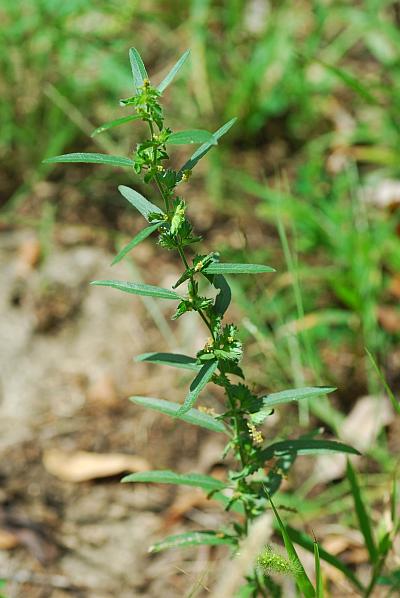Acalypha monococca (Engelm. ex A. Gray) Lill. W. Mill. & Gandhi
One-Seeded Mercury

Native
CC = 3
CW = 5
MOC = 71
© SRTurner
Acalypha monococca (Engelm. ex A. Gray) Lill. W. Mill. & GandhiOne-Seeded Mercury | |
 |
Native CC = 3 CW = 5 MOC = 71 |
© SRTurner |
|
Family - Euphorbiaceae Habit - Taprooted, monoecious, annual forb. Stem - Strongly ascending to erect, to 50 cm, pubescent with short, curved hairs. Plants annual, taprooted, with clear sap.
Leaves - Alternate, short-petiolate, with the petiole 1/4 the length of the blade or less, usually shorter than the inflorescence bracts. Stipules present but minute and deciduous. Blades to 7 cm, linear to lanceolate, much longer than wide, the margins entire or with a few blunt, minute teeth, surfaces pubescent with short, loosely appressed hairs.
Inflorescences - Entirely axillary, 1-3 per node, usually with 1 basal pistillate node below few to several nodes of staminate flower clusters, the tip of the staminate spike usually extending well beyond the bracts. Bracts 1 per pistillate node, leafy, folded longitudinally around the inflorescence, with 9-17 lobes, the margins and outer surfaces moderately hairy, with some of the hairs usually gland-tipped, also with sparse to moderate minute, reddish, sessile glands.
Fruits - 1.8-2.6 mm long, 1-locular, 1-seeded, the surface moderately hairy and occasionally alsowith sparse, minute, sessile glands, lacking tubercles at maturity. Seeds 1.6-2.4 mm long. Flowering - May - October. Habitat - Glades, upland prairies, sand prairies, ledges, savannas, forest openings, railroads. Origin - Native to the U.S. Lookalikes - A. gracilens and other species of Acalypha. Other info. - This common species of mercury inhabits drier habitats than the others. In general appearance it is similar to A. gracilens, which also has narrow leaves. It is easily distinguished from that species by its single-seeded fruits, which are round in profile rather than three-lobed. Although not particularly showy, it is usually found in less disturbed areas and is therefore a welcome find. Missouri is near the northern end of the plant's range, which extends southward through lower Texas. Photographs taken at LaBarque Creek Conservation Area, Jefferson County, MO, 8-28-2018, and Rockwoods Reservation, St. Louis County, MO, 9-3-2018 (SRTurner). |